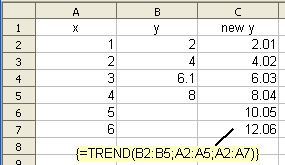Difference between revisions of "Documentation/How Tos/Calc: TREND function"
From Apache OpenOffice Wiki
< Documentation | How Tos
m |
m |
||
| (8 intermediate revisions by 3 users not shown) | |||
| Line 1: | Line 1: | ||
| − | __NOTOC__ | + | {{DISPLAYTITLE:TREND function}} |
| + | {{Documentation/CalcFunc ArraysTOC | ||
| + | |ShowPrevNext=block | ||
| + | |PrevPage=Documentation/How_Tos/Calc: TRANSPOSE function | ||
| + | |NextPage=Documentation/How_Tos/Calc: Complex Number functions | ||
| + | }}__NOTOC__ | ||
== TREND == | == TREND == | ||
| Line 15: | Line 20: | ||
=== Example: === | === Example: === | ||
| − | [[Image:Calc_trend_example.png| | + | [[Image:Calc_trend_example.png|CENTER]] |
| + | |||
<tt>'''=TREND(B2:B5; A2:A5; A2:A7)'''</tt> | <tt>'''=TREND(B2:B5; A2:A5; A2:A7)'''</tt> | ||
: when entered as an array formula in cell C2, where the x values in A2:A7 are 1,2,3,4,5, 6 and the y values in B2:B4 are 2, 4, 6.1, 8 returns {2.01|4.02|6.03|8.04|10.05|12.06}. The data points are very nearly on the line y = 2x (and would be if B4 contained 6 instead of 6.1). The best fit line found is therefore very nearly y=2x. | : when entered as an array formula in cell C2, where the x values in A2:A7 are 1,2,3,4,5, 6 and the y values in B2:B4 are 2, 4, 6.1, 8 returns {2.01|4.02|6.03|8.04|10.05|12.06}. The data points are very nearly on the line y = 2x (and would be if B4 contained 6 instead of 6.1). The best fit line found is therefore very nearly y=2x. | ||
| Line 21: | Line 27: | ||
<br style="clear:both;" /> | <br style="clear:both;" /> | ||
| − | {{ | + | {{SeeAlso|EN| |
* [[Documentation/How_Tos/Calc: INTERCEPT function|INTERCEPT]] | * [[Documentation/How_Tos/Calc: INTERCEPT function|INTERCEPT]] | ||
* [[Documentation/How_Tos/Calc: SLOPE function|SLOPE]] | * [[Documentation/How_Tos/Calc: SLOPE function|SLOPE]] | ||
Latest revision as of 13:43, 1 February 2024
TREND
Fits a straight line to data using linear regression and returns points on that line.
Syntax:
TREND(yvalues; xvalues; new_xvalues; type)
- yvalues and xvalues are single row or column ranges specifying points in a set of data.
- TREND fits a straight line through these data points, using the linear regression method.
- If type is 0 the straight line found will pass through the origin; if type is non-zero or omitted the best fit straight line will be found.
- TREND returns an array of the y values of the straight line found, corresponding to the x values in new_xvalues (or if omitted xvalues). It must be entered as an array formula (for example by using Cntrl-Shift-Enter rather than just Enter).
- yvalues and xvalues must be the same size. new_xvalues may have a different size.
Example:
=TREND(B2:B5; A2:A5; A2:A7)
- when entered as an array formula in cell C2, where the x values in A2:A7 are 1,2,3,4,5, 6 and the y values in B2:B4 are 2, 4, 6.1, 8 returns {2.01|4.02|6.03|8.04|10.05|12.06}. The data points are very nearly on the line y = 2x (and would be if B4 contained 6 instead of 6.1). The best fit line found is therefore very nearly y=2x.
- This example shows how TREND may be used to predict future values.
See Also
